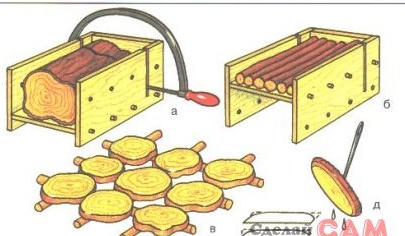An oak branch, a cap, a knotty pine or birch log rotted inside the aspen or poplar are all excellent natural materials, from which you can make a beautiful stand for crafts or a large decorative stand for a vase or teapot.
The technology for producing wood slices in home The conditions are simple. A log, a thick branch or a cap is placed between special resistant walls and is sawn by a beam saw into disks 8-10 mm thick (Fig. A). If the log is very thick, it can be previously split in half. For sawing thinner workpieces with a diameter of 5-6 mm, you need to make an additional removable shield and lay the workpieces in pieces at a time (Fig. B).
A large log is best sawed raw, and small logs should be pre-dried without peeling the bark.
Slices obtained from large workpieces or burls can be warped during drying, so before drying they need to be stacked and squeezed with clamps or twisted with wire. In addition, it is advisable to lay the slices with wooden gaskets. When the workpieces have dried, they can be cleaned of bark. But if a cut of wood or burl is used as a stand for crafts, then the bark is not removed and must be smeared with polyester varnish.
In fig. The decorative stand from thin sections of tree knots of various configurations is presented.
In addition to supports, from a knot of oak or a trunk of a young oak, willow, you can make wall panels, various decorations: brooches, pendants, bracelets. To do this, the workpiece must be dried without removing the bark, then sawed into transverse straight or oblique sections. Each section on the front side is ground and then dipped in polyester varnish, and to make it more convenient, they are pre-pierced with a thick needle (Fig. D, e). When the varnish hardens, the surface of the product is again ground with a fine sandpaper and polished.

